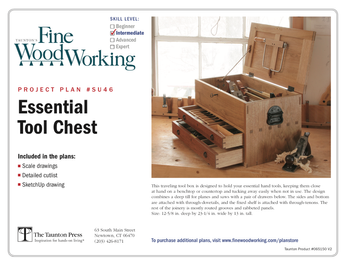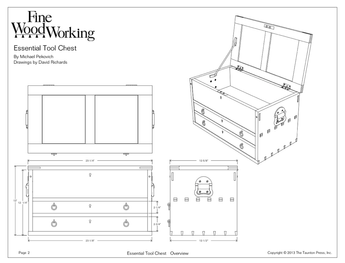Is there a general formula for calculating how long & how thick a tenon should be? For example, if the width of the material to be joined is 2″ and it is 3/4″ thick, what should the dimension of the tenon be? I will be doing loose tenons. In the example listed above, I was thinking the mortise should be 1 5/8″ (3/8″ from the edge) and the tenon would be 3/8″ thick. I would plan on the tenon being 1/16″ shorter than the mortise to allow for glue. Does this seem right? Comments appreciated
Discussion Forum
Get It All!
UNLIMITED Membership is like taking a master class in woodworking for less than $10 a month.
Start Your Free TrialCategories
Discussion Forum
Digital Plans Library
Member exclusive! – Plans for everyone – from beginners to experts – right at your fingertips.
Highlights
-
Shape Your Skills
when you sign up for our emails
This site is protected by reCAPTCHA and the Google Privacy Policy and Terms of Service apply. -
 Shop Talk Live Podcast
Shop Talk Live Podcast -
 Our favorite articles and videos
Our favorite articles and videos -
E-Learning Courses from Fine Woodworking
-
-
 Fine Woodworking New England Event
Fine Woodworking New England Event -












Replies
Your measurements are good. I also like loose tenon. why do 2 seperate operations when one does the job without any strength sacrifice. One little tip. Band saw or dovetail saw a couple very shallow groves in the loose tenon. These will allow the glue to escape.
I'd always heard that the M&T thickness should be about 1/3 the thickness of the wood, which in your example would translate to 1/4". At 3/8" your tenon wall is only going to be 3/16" thick. Seems a little thin to me, but wait til others weigh in to see what they think.
I love the smell of sawdust in the morning.
Working with handtools the woodworker uses a dimension closest to one-third the thickness of the workpiece for which he has a mortise chisel on hand. In the example you provide, I would cut a 1/4" tenon in most instances. By definition, a frame being built from 3/4" stuff is pretty lightweight, therefore a quarter inch thick tenon would work fine. If you had to, repositioning the tenon might allow you to go thicker if judgment pushed you to that conclusion.
Typically, you work on the rule of "thirds", bones. I was trained according to traditional English methods and rules.
This would make your tenon 1/4" thick and about 1 1/4" long.
As Chas said, but, if you're chopping mortices by chisel, you pick a chisel width you have (having said this, I was trained by a German Master cabinetmaker to use, say, a 1/8" chisel to cut a 1/4" mortice, so you can make a mortice of unusual size should you wish)
Cheers,
Andrew
I'm with others here in saying that a 3/8" mortise would be too large on 3/4" stock. The problem is that the wood around the mortise becomes too scant, and then is prone to splitting and failure.
I'm an engineer, by the way, so I tend to look at things from a mechanical point of view, of course. <g> It's very tempting to want to use thicker tenons because they seem stronger. However, the strength of the joint is a function of glue area and shear strength. Even a 1/4" x 1" (in cross-section) tenon has plenty of shear strength (just try breaking it in pure shear to prove it to yourself!).
Regarding glue area, the length of the tenon is more important than it's thickness. This is because the narrow tenon faces are adjacent to end grain when assembled, and end grain is just about negligible when it comes to effective glue adhesion.
So I'd use a 1/4" thick tenon in this case. The 3/8" margins you're proposing to define the remaining dimensions sounds about right. You could probably use 1/2" margins, too.
Thanks for the response. And to all that responded. I will narrow the stock (tenon) down and I like the 1/3 method mentioned mentioned in the thread. I will be cutting with router bits, so the 1/4 & 3/8 will be the primary dimensions I will work with. If the stock gets very thick I will use dual tenons. I guess experience will tell me the rest. I am a hobbyist, so I will be with the pieces in the future, and I have a failure, then I will know I did something wrong.
The wife wants a medicine cabinet in the bathroom. The doors will have a stained glass panel in it. With the added weight of the glass panel, and the stress of the door opening and closing, I want to make sure I do the corners right. Thanks again.
Bones,
I just made and hung a cabinet in the master bathroom a few weeks ago. This is not a cast in concrete suggestion, but if possible, use quarter sawn stock....or a at a minimun, stock that is naturally relatively stable. I've gotten a bit of twist in my painted poplar piece....
This forum post is now archived. Commenting has been disabled